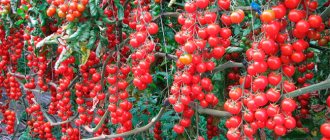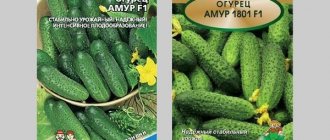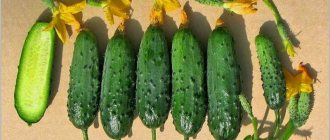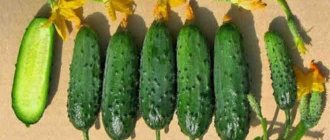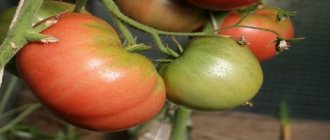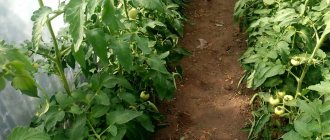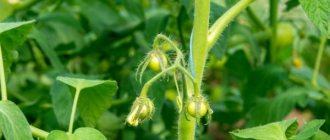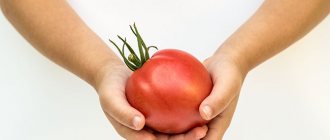Masha cucumbers belong to the F1 class hybrid, are distinguished by a high level of productivity, rapid ripening, resistance to many diseases and excellent taste. They are considered an early self-pollinating gherkin, which has the property of long-term storage. For this reason, the fruits are actively grown for wholesale sales.
Cucumber seeds “Masha”
Orurians “Masha”
The “Masha” variety is a record holder for yield: More than 10 kg of cucumbers can be harvested from one square meter
Description of the variety Masha
Class F1 means that the cucumber is a first generation hybrid, the seeds of which are grown through labor-intensive and lengthy selection. Namely, during the breeding of the variety, various types of gherkins were crossed, cross-pollinating and artificially pollinating them.
Masha can be considered a heterotic variety, that is, it is a cucumber that is superior to its “parents” in all characteristic indicators. These factors indicate that seeds collected at home are not replanted, since improved characteristics can be achieved exclusively through first-generation selection.
The plant belongs to the determinate species (the main stem stops growing after the formation of a cluster with flowers). It has a limited number of shoots, which are characterized by power and average height. In this case, when forming a bush, shoots can be placed vertically and horizontally. Feature - Masha is grown both by seedlings and by seeds (in a greenhouse, on open ground).
Appearance
Characteristics of bushes:
- climbing – average;
- leaves – slightly wrinkled, medium size;
- flowering is female (due to this there are no barren flowers);
- there can be 6-7 ovaries in one node.
Fruit characteristics:
- shape – cylindrical, tuberous;
- the surface is pimply with a light white fluff;
- color – dark green with light stripes and spots;
- the weight of one fruit varies from 90 to 100 grams;
- length – 8-11 cm;
- diameter – from 3 to 3.5 cm;
- the pulp has increased juiciness;
- the peel is crunchy;
- bitterness – absent;
- there are no voids inside;
- the skin is thick, compacted.
The Masha variety has a wide range of uses - canning, pickling, eating as a salad, etc. The peculiarity is that even after salting and heat treatment, elasticity and crunch are retained.
Ripening time and yield
The first harvest can be harvested 36-40 days after the appearance of primary shoots. For mass harvesting, it is enough to wait a few days.
To achieve maximum yield, ripe greens must be harvested every day. This makes it possible for new ovaries to form.
Masha's fruits do not grow more than 11 cm, do not yellow, but if they are not picked, the yield decreases and the taste deteriorates. This is due to the fact that greens are parthenocarpic.
If we talk about productivity, then from 1 sq. m you can remove up to 10 kg of cucumbers. In this case, the last harvest is harvested in late September - early October.
Cucumber Masha F1: description and characteristics from the manufacturer
UNIQUE, ULTRA-EARLY, SALTED HYBRID! RESISTANT TO LOW TEMPERATURES. A very early gherkin hybrid, distinguished by excellent taste, without bitterness. The fruits have a rich green color and beautiful appearance, so they are suitable for growing not only for personal consumption, but also for sale. The fruits are consumed fresh, added to salads, and they are also very tasty in pickled and canned form.
These cucumbers are not only tasty, but also healthy, because they consist of 95% water, which contains fiber, sugar, potassium, calcium, magnesium, phosphorus, iodine, vitamins B, C. In a word, not a product, but some vitamins that are good for the body.
Characteristics of Masha f1 cucumbers:
- For open ground
- For closed ground
- Planting pattern: 50x40 cm
- Fruit length: 8-12 cm
- Fruit diameter: 3-3.5 cm
- Fruit weight: 90-110 g
- Ideal for canning
- Used fresh
Features of planting and care
Caring for gherkins and planting them does not require special skills, but there are still rules that must be followed.
Seed selection and preparation
Seed material must be prepared regardless of the chosen method of cultivation and planting. On sale you can find seeds that have already been processed (they are painted in bright colors).
If the seeds have not been disinfected, then you need to place them in a light manganese solution for 15 minutes. After this, drain the liquid, place the seeds on moistened gauze and cover with it. So the seed material should lie for 5 days (the fabric is periodically moistened with water). At the moment when the grains are placed in the solution, it is necessary to select the hollow elements. They always float to the surface.
Site selection and soil preparation
Proper crop rotation requires space. There should be no predecessors in the form of pumpkin, squash, zucchini, or melon on the site. It is best to sow Masha after cauliflower and white cabbage, legumes and onions.
Soil preparation is required. It is advisable to do it in the fall. To do this, add a solution of 1 liter of wood ash, 3 buckets of manure, 100 grams of nitrophosphate fertilizer (this dosage is calculated for 1 sq. m). If fertilizing was not carried out in the fall, then at the beginning of spring you need to remove 20 cm of soil, add a layer of manure and cover it with the removed soil, and then form the beds.
If the cucumber is grown by seedlings, then the land is prepared in a different way:
- combine peat, sand, humus, soil with leaves in equal proportions;
- disinfect the soil by heating or scalding with boiling water.
The planting method is selected based on the cultivation method - seedlings or non-seedlings.
Watering
It is recommended to water Mash in the early morning or late evening. Otherwise, the cucumbers will get sunburned. To maintain an optimal level of moisture in the soil (minimum 75%, maximum 85%), irrigation is carried out by drip. If this is not possible, water is supplied from a watering can with a small nozzle.
Watering rules depending on the planting method:
- In the open ground, Masha is watered based on the amount of precipitation. It is necessary to loosen the soil not immediately, but the next day.
- When grown in greenhouse conditions, watering is carried out every other day. One bush requires an average of one and a half liters of water.
It is strictly forbidden to use cold water (mostly warm) for irrigation. This is due to the fact that the yield decreases and the inflorescences fall off.
Fertilizer application
Fertilizing is carried out after 10-14 days, but the first application of fertilizers is recommended on the 18th day after planting in a permanent place. Throughout the entire period, you need to alternate fertilizers (minerals and organic matter). Traditional medicine - infusion of dandelion, nettle, yeast - are also excellent for recharging. Periodically it is necessary to spray the plants with Bordeaux mixture, a weak solution of manganese, and liquid from wood ash.
Feeding rules based on the planting method:
- When planting seeds in the garden, fertilizing is carried out up to 6 times during the flowering and growth of greens. Initially, you need to add a urea solution (1 box of matches per bucket of water). Next, potassium and phosphorus are needed.
- If cucumbers are grown in a greenhouse, then Kemira Lux fertilizer is first applied (1 tablespoon of minerals per bucket of water). Afterwards, organic fertilizer is required (for 10 liters of water, 1 liter of mullein, 20 grams of ash).
Weeding and loosening
Aeration allows you to saturate the soil with a sufficient amount of oxygen and nutrients, so that it remains light and fluffy. Weeding is needed to remove weeds that absorb essential minerals and water and do not allow the root system of cucumbers to grow.
Loosening and weeding are carried out as the weeds grow. On average this is once every 7-14 days. After these manipulations, it is recommended to hill up the bushes. The tool is not deeply deepened into the soil, as there is a risk of damage to the roots.
How to form a bush correctly?
The yield depends on how well the bush is formed. To do this, you need to pinch shoots, tendrils, ovaries, remove leaves, and direct creeping shoots in a certain direction. It is advisable to grow masha on a trellis, which creates comfortable conditions for ventilation and collection.
To increase productivity, experts advise forming just one stem. How to do it:
- separate 4 leaf axils from below, remove ovaries and shoots here;
- in the other 4 leave one leaf and one ovary;
- after that, from 9 to 12 axils remain - two ovaries and two leaves;
- from 13 to 16 sinuses it is necessary to leave three ovaries and three leaves;
- Then everything is removed and the place of growth is pinched.
The tendrils must be removed and the stem placed on a wooden support.
Features of seedling and non-seedling growing methods
Seedling method
The seedling method of cultivating crops makes it possible to harvest the crop as early as possible. In addition, it is possible to control conditions - temperature, level of illumination and humidity. In this case, you must adhere to the following rules:
- When seeds are planted, the temperature should not exceed 28 degrees. How to plant cucumber seedlings - read here.
- When the first shoots appear, the temperature decreases (maximum +18).
- 7-10 days before picking to a permanent place, the seedlings are hardened. To do this, the culture is taken to a cool place (first for an hour, then the time gradually increases).
- When replanting, actions must be careful, since the roots are still weak. For this, experienced gardeners recommend planting seed material in half-liter pots made of peat and humus.
- In the greenhouse, the bush develops until strong 3 leaves are formed, after which it is transferred to the garden bed.
Growing sprouts in greenhouse conditions has many advantages, but there is also a significant drawback - poor ventilation and high humidity create favorable conditions for the development of pathogenic microorganisms.
To avoid infection of plants, the greenhouse is disinfected. Usually these are special smoke products that are installed evenly throughout the room and set on fire. In this state, the greenhouse should stand for 5 days, after which it is recommended to thoroughly ventilate the “room”. Make sure that there are no cracks through which the disinfectant can escape.
Other recommendations:
- Once every three years, remove the top layer of soil in the greenhouse (maximum 7 cm) and replace it with new soil.
- Add compost, loam, and horse manure to the soil.
- It is useful to apply potassium, phosphorus, and organic fertilizers. For this, wood ash, superphosphate, and urea are used.
In the modern world, you can find peat tablets on sale for planting seeds that do not damage the root system when transplanting seedlings. The seed is embedded in a tablet, and when the seedling is transplanted, you need to remove the protective film and plant the sprout in the ground.
Seedless method
In open soil, seeds are sown exclusively in well-warmed soil. The site should be moderately sunny (there should be shade during hot hours) and without drafts. The following requirements are then adhered to:
- 20 days before planting seeds in open ground, digging is carried out to the depth of a shovel.
- At the same time, humus or compost is added (dosage per 1 sq. m - a bucket of fertilizer).
- When planting, add a handful of humus and 1 tbsp to each hole. l. urea.
- Water the hole with water and place the seed.
- Mulch and cover with plastic wrap. Leave it like this until the first shoots form. To ensure they appear evenly, maintain the same depth of seed placement.
The seed material goes deep into the soil by 2-3 cm, no more. The horizontal type of growth (stems lie on the ground) assumes a planting pattern of 80x60, the vertical type (a trellis is used) - 20x100 cm.
Care
Basic recommendations for caring for the hybrid Mashenka (F1):
- Watering 2-3 times a week with warm and settled water;
- Weeding;
- Loosening the soil in beds with cucumbers;
- Fertilizing with organic matter and liquid mineral fertilizers.
Hilling is carried out after the seedlings have been strengthened in the ground, and in the case of direct sowing of seeds - after the appearance of stable, friendly shoots.
During the flowering of the bushes, watering is carried out once every 10 days together with fertilizing. Plants respond well to an aqueous solution of urea or liquid manure.
Diseases and pests
The Masha variety is quite resistant to many diseases that are inherent in cucumbers. However, unfavorable conditions, as well as inadequate care, contribute to the following diseases:
- Cucumber mosaic. Characterized by deformation of fruits and leaves, mottling. For preventive purposes, it is necessary to remove weeds and treat the leaf part with ash (moisten the leaves with water from a spray bottle, sprinkle crushed ash). For the fight, the drug Fundazol is used.
- White rot. It appears as a whitish fluffy coating on fruits, stems, and foliage. To prevent the development of white rot, the bushes are covered with film when the temperature drops sharply. To get rid of the disease that has arisen, you will have to remove and destroy the affected areas. The rest of the bush is sprayed with a special solution (take 10 grams of urea and a couple of grams of copper sulfate per bucket of water).
- Powdery downy mildew. Signs of pathology are the formation of brown spots on the leaf part of the plant, a fluffy coating that occurs as the disease progresses. For prevention, the leaves are sprinkled with crushed wood ash. Fundazol is used for treatment.
- Anthracnose. Characterized by leaf damage (white or yellowish spots form). To avoid infection, it is necessary to spray the plant with a weak solution of manganese. For the fight, the drug HOM, Ridomil Gold, is used. Diseased areas are removed.
Like any variety of cucumber, Masha is loved by pests. Among the insects most often attacked are the following:
- Aphid. The pest can be recognized by the following signs: curling of leaves, formation of spots on them. In addition, the ovaries and color begin to rapidly fall off. You can prevent insect infestations and get rid of them by spraying with the following means: a solution of tobacco dust;
- drug Fitoverm;
- soapy water (use dark laundry soap);
- infusion of wood ash.
- frequently loosen the soil while sprinkling it with tobacco dust or wood ash;
- remove weeds in a timely manner;
- wash the stems and leaves with water and laundry soap;
Harvest and storage
You can start harvesting when the fruit reaches 8 cm in size. You should not wait for the cucumber to grow to 10-11 cm, as in this case the peel becomes thicker.
If the seedling cultivation method is used, then the harvest period can be considered 37-40 days after the emergence of seedlings. When the seed is immersed in open ground, the ripening time increases by 2-3 weeks.
It is recommended to store the vegetable in the refrigerator for no more than 28-30 days. Can be used for salads, canning, pickling.
History of variety selection
Cucumbers of the Masha f1 variety are a first generation Dutch hybrid. The hybrid was obtained thanks to the efforts of breeders in 1999. The Masha hybrid was included in the state register of the Russian Federation in 2000. Favorable regions for cultivating these cucumbers are not indicated.
The lack of regionalization means that this hybrid can be grown with equal success in many regions of Russia. Judging by the reviews, Masha’s cucumber has gained popularity both among amateur vegetable growers and among farmers who grow vegetables for sale. Hybrid Masha is grown in open ground, a greenhouse, and under temporary film covers.
Pros and cons of Masha cucumbers
Advantages of the Masha variety:
- speed of maturation;
- crunch even after heat treatment;
- excellent taste indicators;
- unpretentiousness of care and cultivation;
- resistance to diseases and pests when properly maintained;
- ability to bear fruit without pollination (parthenocarpy);
- the ability to grow in different ways (horizontally, vertically, seedlings and non-seedlings);
- wide range of uses;
- high yield.
Flaws:
- there is no possibility of collecting seeds (you need to buy new ones every year);
- weakness of the root system (you need to be careful when transplanting seedlings).
Advantages and disadvantages
The main advantages of the Mashenka variety (F1) are:
- High yield;
- Formation of fruits without pollination by bees;
- Great taste of greens;
- Friendly fruiting;
- Early maturation;
- Resistance to viruses and fungi;
- High commercial quality of fruits;
- Good transportation of the harvested crop;
- Simple rules of agricultural technology.
REFERENCE: Particularly popular are small greens, which are collected at the gherkin stage (5-6 cm) or pickles (3-4 cm). Cucumbers are great for pickling and pickling.
The disadvantages of a hybrid include:
- The fruits ripen very quickly, so they must be collected on time;
- When overripe, greens lose their taste and aroma.
Reviews
★★★★★
Nikolay, 28 years old. I have been planting Masha for about 6 years using the seedless method.
Of course, I harvest the harvest a little later than when transplanting seedlings, but there is no need to fool your head - throw the seeds into the ground and take care of them. Cucumber is disease-resistant, unpretentious and tasty. ★★★★★
Marina, 56 years old. I plant cucumber Masha as seedlings, then transfer them to open ground.
But for planting seeds I use peat tablets - very convenient and safe for the root system. I use the fruits for salads and canning. But I collect them when the cucumber reaches 8-9 cm in length, no more. This makes the skin very tender and crispy. The only pity is that you have to buy new seeds every year. ★★★★★
Valentina, 44 years old. I really like the Masha variety for its unpretentiousness and ease of care.
But I’m especially pleased that they don’t need to be pre-soaked in water before canning. And I harvest fresh every day. The taste is excellent, the smell is aromatic, there is crunch and juiciness. Hide
Add your review
Features of hybrid agricultural technology
As noted above, this hybrid is unpretentious, but only with good care can you get good results. And if you have already spent money on buying seeds, it would be very unwise to leave these beauties without proper care.
Growing seedlings
Almost all hybrids from Dutch agricultural companies are sold with seeds that have already been processed. Hybrid Masha is no exception; its seeds are treated with Tiram, so they do not require any pre-sowing preparation.
ON A NOTE! Cucumber seeds that have been treated to remove fungal spores have a beautiful green or turquoise color.
This hybrid is grown as seedlings; also in the southern regions of the country, the seeds can be sown directly into the ground. The timing of sowing is determined by the method of cultivation, as well as the climatic characteristics of the region.
With the seedling method, cucumbers are sown about a month before planting in the ground, so you first need to determine the approximate timing and then plan the sowing.
In the middle zone, seedlings are planted in a greenhouse in early or mid-May, in open ground - at the end of May or already in the first days of June. In regions with more severe climatic conditions, the dates are shifted, but in any case it is necessary to focus on the weather.
It is advisable to immediately sow cucumbers in separate pots of sufficiently large volume (0.5 liters) so that the roots of the plants feel as comfortable as possible. Special peat pots are suitable, which are then immediately installed in the holes.
You may be interested in: Favorable days for transplanting cucumbers in open ground Dates for planting cucumbers in May 2021 according to the lunar calendar The most favorable days for planting cucumbers in the Leningrad region according to the calendar of gardeners and gardeners
Grow seedlings at a temperature of +23ºC…+25ºC, regularly watering the plants. Watering is only with warm water, and this rule also applies to adult plants.
The optimal age of cucumbers ready for planting is 23-25 days, and the soil temperature should be +14ºC...+16ºC. For better adaptation and to protect plants, you can make shelters for cucumbers using non-woven materials and large plastic bottles.
The air should warm up to +22ºC…+25ºC, at night to +18ºC.
Video review of the Masha variety
This video talks about the features of Masha cucumbers, what they look like, why they are remarkable, and how to care for them:
The cucumber variety Masha enjoys well-deserved attention among all gardeners and farmers. It is characterized by high yield, excellent storage and transportability. But for this you need to follow simple rules of planting, growing, care and collection. This is an indispensable vegetable at any time of the year.
0
0
Copy link

